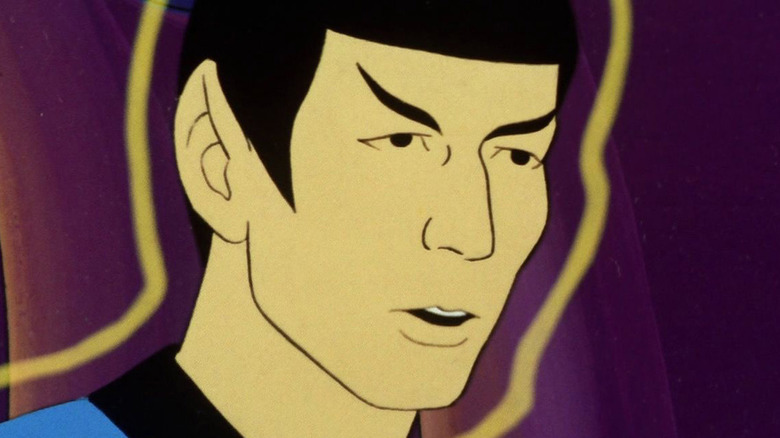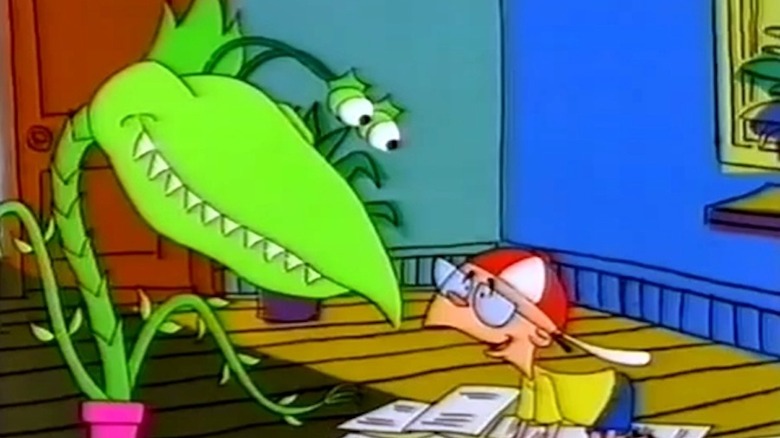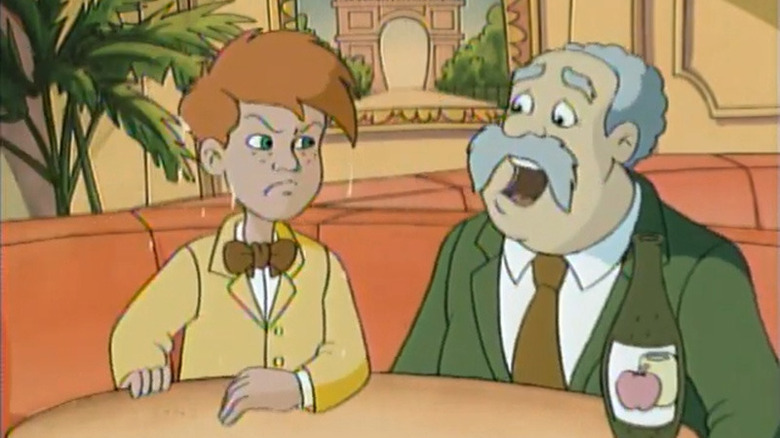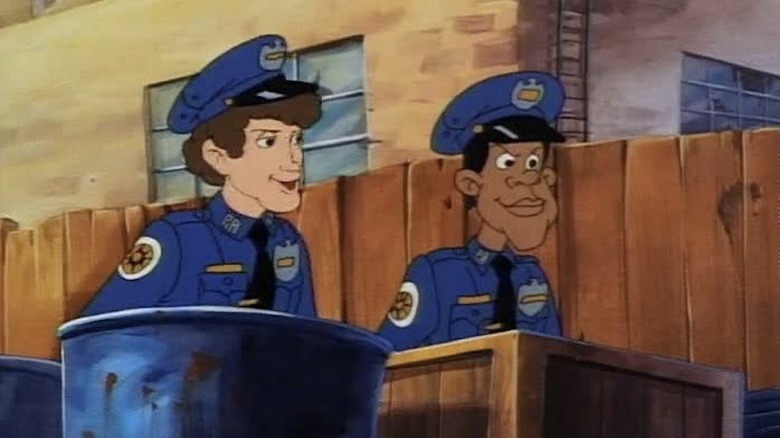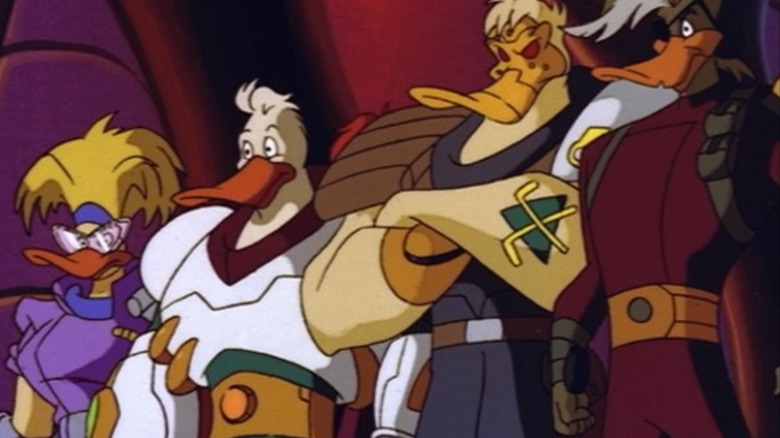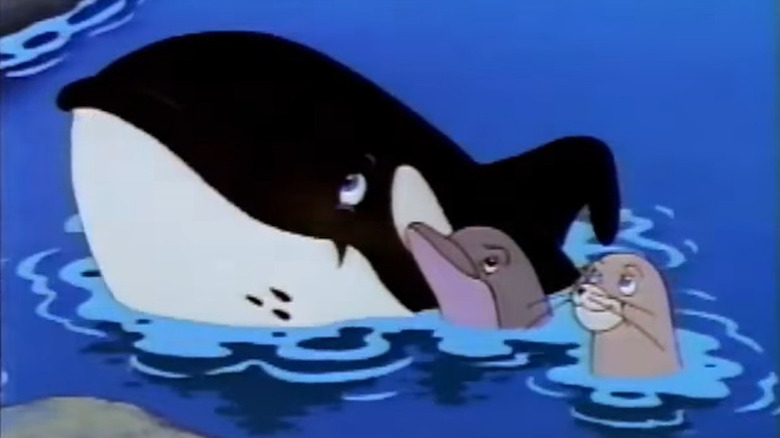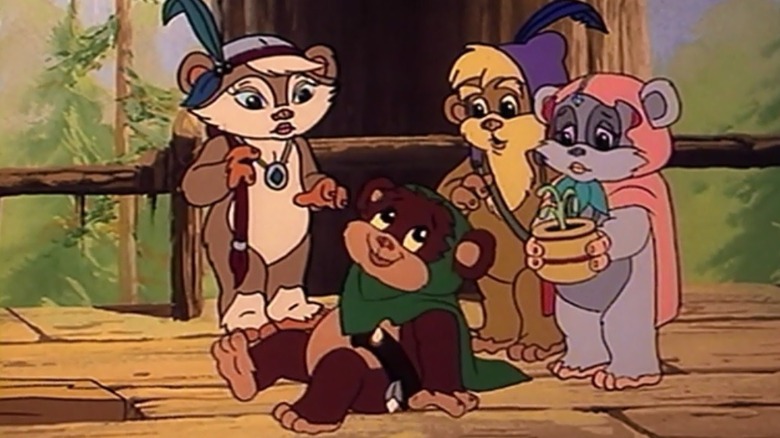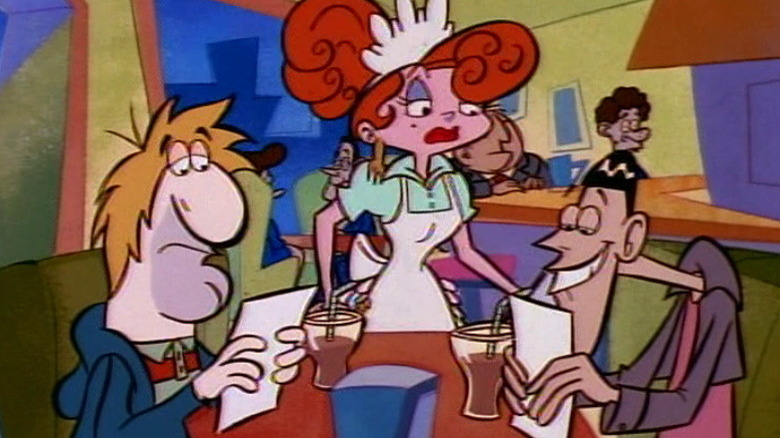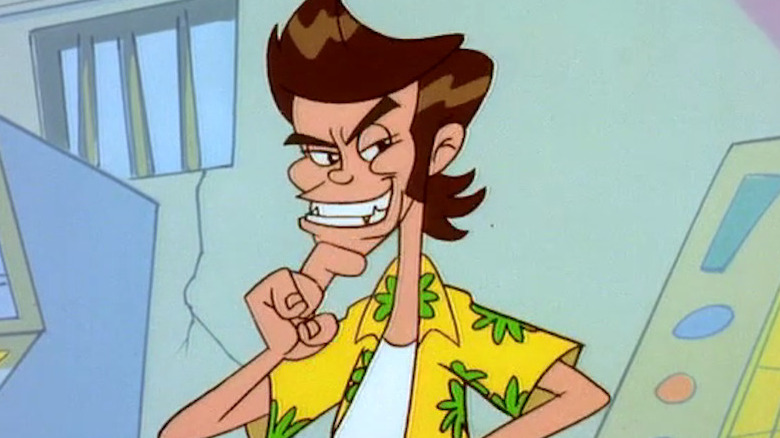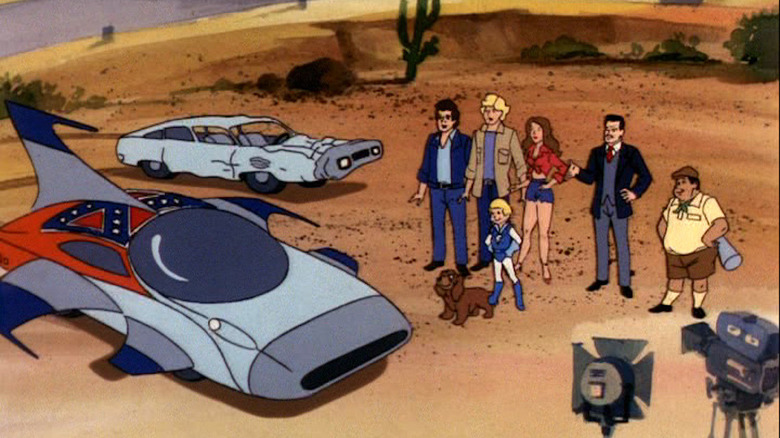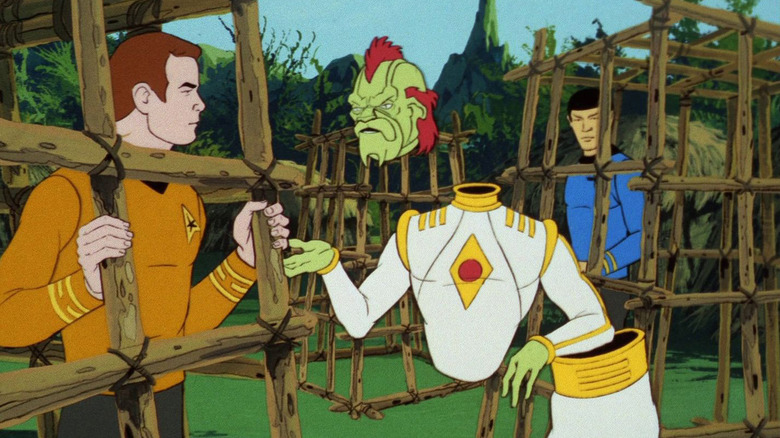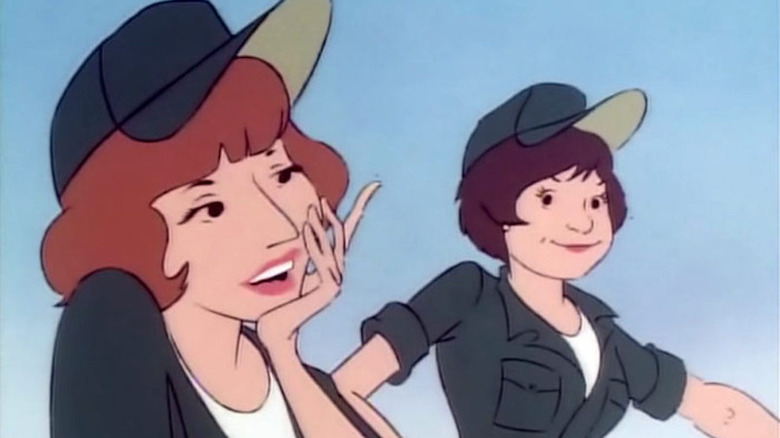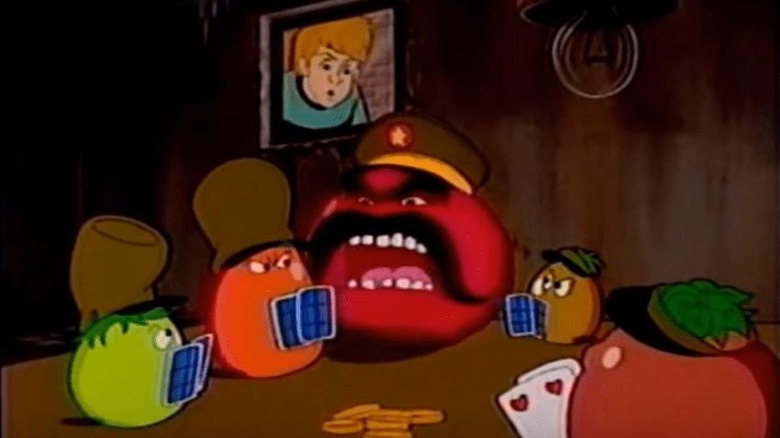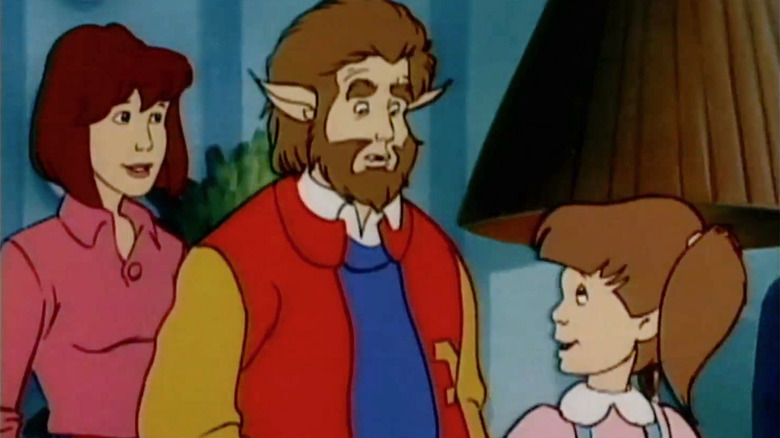The Worst Animated Series Based On Live-Action Franchises
No matter what decade you grew up in, you probably had a favorite animated series. Children of the '70s loved "Super Friends," '80s youngsters had "He-Man and the Masters of the Universe," and '90s kids loved "Teenage Mutant Ninja Turtles." While many TV cartoons are entirely original, the medium has a long history of adapting comic books, animated movies, and fairy tales for the small screen. Some even spring from live-action franchises.
Cartoon producers tapping into a hot movie or TV show isn't an inherently bad idea. Productions like "The Real Ghostbusters" and "Men in Black: The Series" are immense fun. But this approach has also led to a lot of duds. Bizarre, boring, and simply inexplicable adaptational choices confuse audiences and disappoint fans. Cheap animation keeps genuine wonder from taking hold. Middling voice acting dooms the enterprise to knock-off status. Some of these cartoons have nostalgic appeal, but none will ever be confused with the best of the franchise. From alien mallards to talking vegetables, these are the worst animated series based on live-action franchises.
Little Shop
Roger Corman's 1960 black comedy "The Little Shop of Horrors" tells the story of a man-eating plant dubbed Audrey II, whose owner, the awkward Seymour, struggles to keep up with its appetite. The musical adaptation, "Little Shop of Horrors," hit the Off-Broadway circuit in 1982. That musical was adapted into yet another film in 1986, starring Rick Moranis and Steve Martin.
Flash-forward half a decade, and someone thought there was no better franchise to adapt for kids than this sickening story of bizarre, bloodthirsty, botanical beasts. 1991's "Little Shop," a Saturday morning cartoon, tones down the more horrific elements: Seymour is a geeky '90s pre-teen and Audrey II, rechristened Junior, is little more than a talking plant with a big appetite who can also hypnotize people. This not only sanitizes the story, it takes away everything that makes it funny. The one thing it does retain from previous versions? "Little Shop" is a musical — but it's not a good one. While the animation style is unique and fresh for its era, this show offers nothing for fans of the franchise.
Problem Child
The 1990 family comedy "Problem Child" centers around Junior, an orphaned boy who is adopted by a kind-hearted couple. But Junior turns out to be the kind of kid who wreaks havoc wherever he goes. This madcap misadventure was slaughtered by critics, but it did decently enough at the box office to get a sequel, a made-for-TV threequel, and, in 1993, a goofy animated series.
Junior's comical hijinks could, in theory, work well as a cartoon. The problem is, TV's "Problem Child" is terrible. While the live-action movies mine Junior's antics for ever-so-slightly edgy jokes, the show tries to turn the mean-spirited pre-teen into an endearing character. This just doesn't work, to the point that the animated series somehow manages to be worse than the brutally panned films.
On the plus side, Gilbert Gottfried reprises the role of Igor. In the film, he's the head of the orphanage, but on the TV series, he's Junior's school principal. This is a bright spot — but it's the only one. Somehow, "Problem Child" lasted two seasons and 26 episodes before being brought to a much-needed close, killing off the franchise for good.
Police Academy
The inaugural "Police Academy" is a crude comedy classic that follows a misbehaving group of aspiring cops. Raucous and vulgar, it definitely earns its R rating. Sequels double down on the raunchiness, relying on ever more salacious scenes as the jokes get less witty. All that adult-oriented humor is, of course, perfect fodder for a kiddie cartoon — right? That's what the folks behind 1988's "Police Academy" animated series thought, anyway.
Translating the "Police Academy" characters to animation isn't difficult. The franchise's sophomoric humor, even stripped of its adult nature, proves simple enough to bring to the small screen. The problem is, this kiddie-fied take on the films offers little more than empty slapstick — and not the well-crafted "Looney Tunes" kind. "Police Academy" is full of stories that feel ripped straight out of "Scooby Doo," complete with oddball villains. Needless to say, it bears little resemblance to the movies. Moreover, without the talents of the films' skilled comedians, it's seriously lacking in charm.
Despite being terrible, the powers that be were clearly betting big on the "Police Academy" cartoon's success. They complimented the series with plenty of merchandise, including a full line of toys and a Marvel comic book series. None of this could save it, however: "Police Academy" was buried after just two seasons.
Mighty Ducks
The story of a ragtag group of pee-wee hockey players, 1992's "The Mighty Ducks" prompted a couple of sequels and an actual NHL hockey team. The logical next step was an animated series — but this is where things get weird. Instead of creating a show based on the movie, which is firmly set in our world, the folks at Disney opted to create a bizarre sci-fi saga. "Mighty Ducks: The Animated Series" is inexplicably centered around a group of anthropomorphic duck warriors from another dimension, whose culture is deeply rooted in ice hockey. After an interstellar battle lands them in Anaheim, California, they meet a man named Phil who turns them into an NHL franchise.
"Mighty Ducks: The Animated Series" is a pretty watchable adventure and far from the worst show on this list. But its convoluted and frankly bewildering backstory and lore are unnecessarily confusing. Why they went with a "Teenage Mutant Ninja Turtles" clone for a "Mighty Ducks" cartoon still confounds fans to this day.
Free Willy
An endearing family adventure, 1993's "Free Willy" tells the story of a 12-year-old boy named Jesse, who bonds with a captive orca named Willy. When mighty Willy is threatened by his water park's greedy owner, Jesse must fight to free him. A TV spin-off likely seemed a no-brainer, given the endless potential it presents for cute animal friends. Thus, the animated "Free Willy" series was born.
In this cartoon, Jesse realizes he can communicate with all animals. Empowered by this newfound ability, he sets out to stop those who would endanger the world's creatures. As if this magical addition isn't fanciful enough, "Free Willy" also features a big, bad supervillain known as the Machine. A vicious cyborg, the Machine blames Willy for his dependence on synthetic parts and seeks diabolical revenge. Unnecessarily bogged down by goofy story elements, low-quality animation, and amateurish voice acting, "Free Willy" thankfully wraps things up after just two seasons.
Ewoks
"Star Wars" concluded its first movie trilogy with 1983's "Return of the Jedi." The obvious next step was television. But instead of focusing on the further adventures of Luke Skywalker, the victorious Rebel Alliance, or any number of larger-than-life heroes and villains, "Star Wars" turned to Ewoks. After 1984's "The Ewok Adventure" and 1985's "Ewoks: The Battle for Endor" debuted, an animated series simply titled "Ewoks" hit the small screen in 1985.
Set on Endor, the series follows the adventures of gutsy Wicket and his Ewok family in the years before the events of "Return of the Jedi." They often clash with rival clans, as well as the villainous Duloks, another race that lives on Endor. The Jedi, Rebel Alliance, and Empire are almost entirely absent — this is all Ewoks, all the time.
This makes "Ewoks" a pretty boring watch. It doesn't help that it also suffers from shoddy writing, weak animation, and indifferent voice work. Certain die-hards may have a soft spot for it, but for viewers with no nostalgic attachment to the series, it offers very little entertainment value. Oddly enough, two other bear-focused cartoons also debuted in '85: "The Care Bears" and "Adventures of the Gummi Bears." Both enjoyed greater success and staying power.
Dumb and Dumber
Few comic actors of the 1990s were more beloved than Jim Carrey. A breakout star on TV's hippest sketch comedy show, "In Living Color," he transitioned to movies, where he quickly racked up a string of hits. One of the biggest was the 1994 buddy comedy "Dumb and Dumber," which stars Carrey and Jeff Daniels as a pair of moronic best friends who get caught up in a criminal caper. Carrey's brilliant physical comedy is perhaps the best part of the film, which remains respected to this day.
It took 20 years for a proper sequel, "Dumb and Dumber To," to materialize. But long before that movie hit the big screen, a "Dumb and Dumber" cartoon featuring "Max Headroom" star Matt Frewer and future "SpongeBob SquarePants" icon Bill Fagerbakke debuted in 1995. This lackluster animated series sees the titular twosome take in a purple beaver, which turns them from a pair of friends into a trifecta of troublemakers. While the film draws humor from contrasting these dim-witted dopes with the very real world around them, the cartoon is content to simply be, well, dumb. Basically, it's a watered-down "Ren & Stimpy." No wonder it only lasted 13 episodes.
Ace Ventura: Pet Detective
"Ace Ventura: Pet Detective" stars Jim Carrey as a wacky, animal-based private eye who doesn't exactly have the respect of the law-enforcement community. After the Miami Dolphins' mascot goes missing, however, he's hired to crack the case and bring the missing mammal home. This fun premise combines well with Carrey's zany comedy, which practically screams "cartoon spin-off potential." And that's exactly what viewers got: The animated "Ace Ventura: Pet Detective" series hit the small screen in 1995.
Brimming with low-brow potty humor, "Ace Venture: Pet Detective" managed to earn three seasons. But to modern eyes, it just isn't very good, and certainly doesn't live up to the much more successful film. Despite a crossover with "The Mask," yet another Jim Carrey cartoon, the "Ace Ventura" series never finds its footing. If you're looking for a Carrey-centric animated series that does work, however, make sure to check out "The Mask," which also aired in 1995. In some ways, it's even better than the film.
The Dukes
One of the hottest TV shows of the 1970s and 1980s, "The Dukes of Hazzard" follows misbehaving cousins Bo and Luke as they get mixed up in all kinds of adventures across the Georgia countryside. Notably, "The Dukes of Hazzard" offers one of pop culture's most iconic vehicles, a custom 1969 Dodge Charger known as the General Lee. Big chases, bigger crashes, and all other kinds of vehicular excitement distinguish the series accordingly.
Animated spin-off "The Dukes" debuted in 1983, the height of the live-action series' popularity. Ditching most of the show's criminal aspects, the cartoon centers around the Dukes' attempt to complete in a worldwide race, which antagonists Boss Hogg and Sheriff Rosco are also taking part in. Uniquely, Season 1 of the series stars cousins Vance and Coy Duke instead of Bo and Luke. According to The Los Angeles Times, a salary dispute was to blame. Once it was resolved, Bo and Luke regained their rightful place on both the live-action series and the cartoon.
Ridiculous and condescendingly child-oriented storytelling sucks all the charm out of "The Dukes." Here, the boys encounter everything from Irish leprechauns to Aladdin's lamp. Things become slightly less ludicrous in Season 2, once the behind-the-scenes drama settled, but it's too little, too late. The series was binned after just 7 additional episodes.
Star Trek: The Animated Series
Impressively, 1973's "Star Trek: The Animated Series" brings back nearly the entire original cast of the beloved live-action series, including William Shatner, Leonard Nimoy, DeForest Kelley, and Nichelle Nichols. Original "Star Trek" scribes D.C. Fontana, David Gerrold, and Samuel A. Peeples also contributed scripts, making it as close to a true revival as fans could have hoped for. Moreover, animation allowed the team to dream up stories they never could have pulled off in live-action. The potential, in short, was huge.
Unfortunately, production company Filmation has become retroactively notorious for cheap-looking work, and "Star Trek: The Animated Series" is no exception. Stiff animation and awkward editing make the series hard to sit through, especially for the modern viewer. It's not without its highlights, however. Imagination runs wild on "Star Trek: The Animated Series," allowing for feline crew members, Uhura in command of the Enterprise, and elaborate excursions to undersea kingdoms. But this isn't quite enough to overcome the series' low points. Good thing Trekkies have plenty of other productions to enjoy.
Laverne & Shirley
A spin-off of the wildly popular "Happy Days," 1976's "Laverne & Shirley" stars Penny Marshall and Cindy Williams as a pair of no-nonsense women living in Milwaukee, Wisconsin. It proved almost as big a hit as its parent series, running for eight lengthy seasons. An animated spin-off, 1981's "Laverne & Shirley in the Army," was ordered while the live-action series was still on the air. Both original stars returned to voice their characters.
Rather than tell more stories set in Milwaukee, this oddball cartoon spins out of "We're In The Army Now," a Season 5 episode that sees the two best friends enlist in the armed forces. Though Laverne and Shirley embark on plenty of military hijinks, this cartoon is an undeniably huge step down from the live-action series. Season 2 tries to ameliorate this sorry state of affairs by adding fan favorite Fonzie to the cast and retitling it "Laverne & Shirley with The Fonz." But even this doesn't work. Moreover, as recounted by Today, star Cindy Williams left both incarnations of the show in 1982, requiring Lynne Marie Stewart to step into the animated role. She does an admirable job, but something feels off — a flaw this already lacking series simply can't afford.
Attack of the Killer Tomatoes
"Attack of the Killer Tomatoes," which hit the small screen in 1990, is based on the 1978 cult classic of the same name. A send-up of classic monster movies, this strange flick isn't entirely kid-appropriate, but it's not hard to see how it could make decent fodder for a cartoon. The title alone is incredibly attention-grabbing, as are the visuals. Thus, an animated series was born.
"Attack of the Killer Tomatoes" proved to be relatively short-lived, however, with just 21 episodes across two seasons. Notably, it doesn't sanitize itself, instead embracing the ridiculously over-the-top nature of the film. Because of this, "Attack of the Killer Tomatoes" might be the best of this list's busts. The problem is, it rarely reaches the film's most modest heights of parody. "Attack of the Killer Tomatoes" simply isn't very funny, which makes its out-there attributes feel emptily bizarre and altogether ill-advised. Though some fans of the franchise might hold it up as being on par with the movies, the truth is, most of the movies past the first one aren't very good. This cartoon is one for the discount bin.
Teen Wolf
A surprise hit, 1985's "Teen Wolf" stars Michael J. Fox as a high school basketball player who discovers he's a werewolf. When he transforms, he gains super-strength and agility — but instead of becoming a superhero, he uses his powers to win big games and get girls' attention. In 1986, it became a cartoon of the same name. This time around, nobody knows young Scott is a werewolf. He's also surrounded by a broad family of werewolves, including his Transylvanian grandfather.
Instead of sticking to the movie's earnest comedy-drama, the series opts for wacky misadventures. Unfortunately, they're not the fun or exciting kind. Boring, unremarkable stories ensue, unable to entertain even the least discriminating youngster. Somehow, it earned itself two seasons, though Season 2 ended up getting canceled after just eight episodes. Bad animation, groan-inducing plots, and a generally amateurish tone make "Teen Wolf" among the worst animated series ever made.
